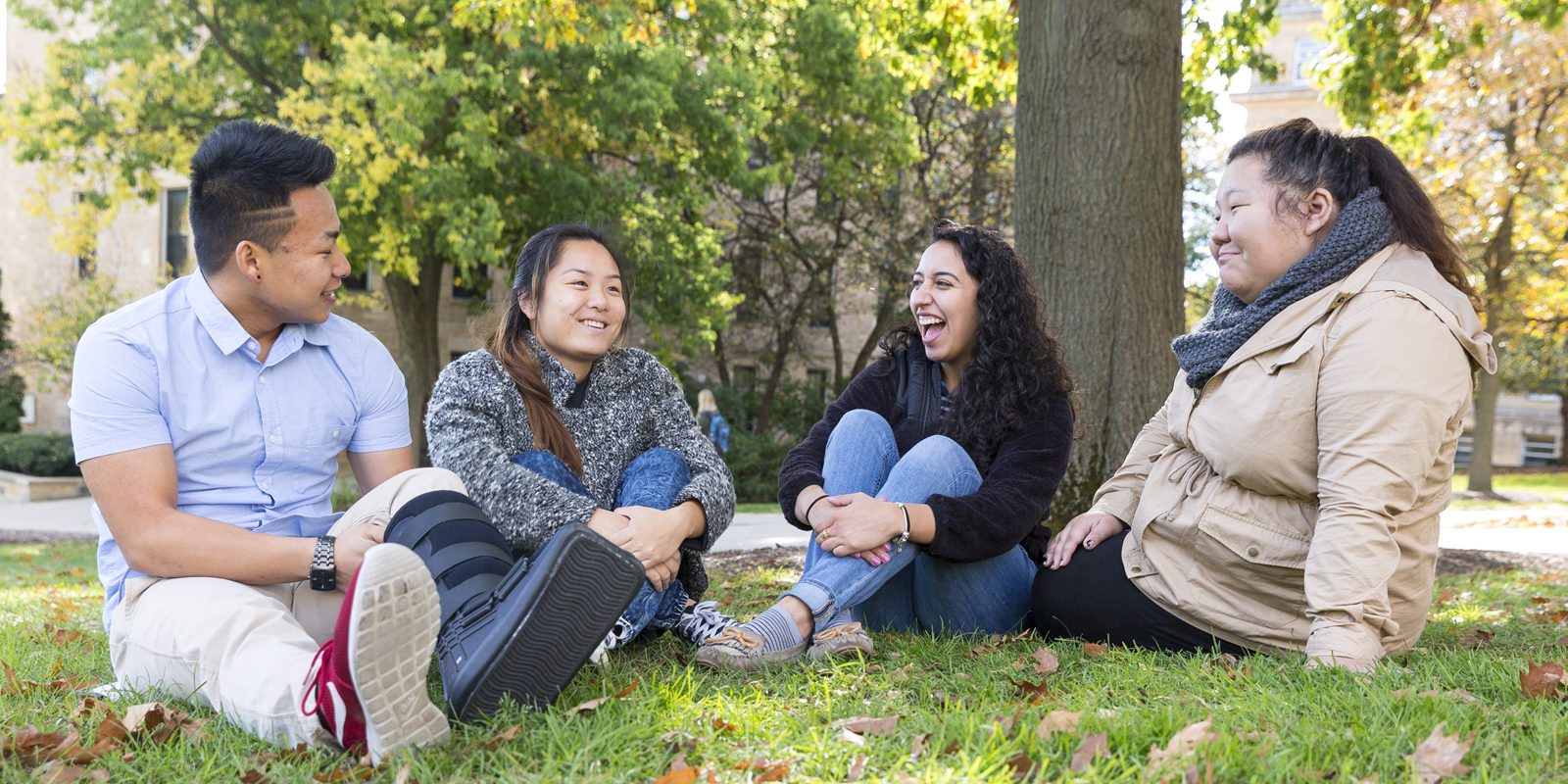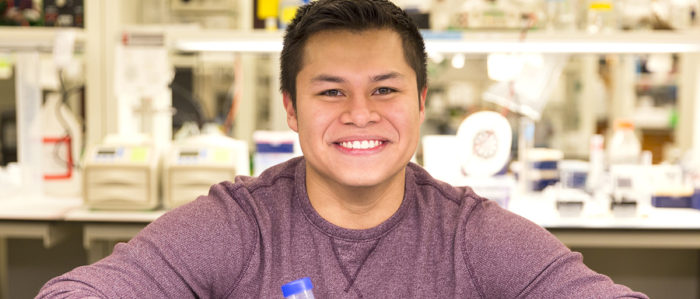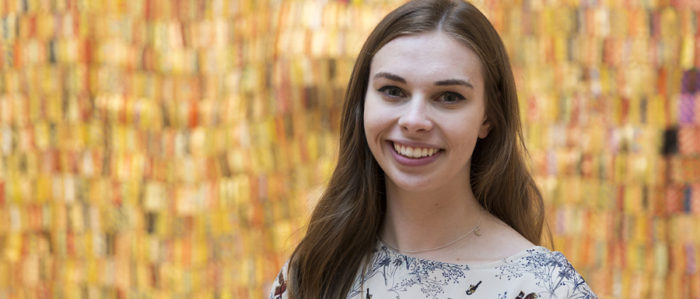Abike Sanyaolu sits at her desk in her Bascom Hall office, scrolling through her contacts on LinkedIn. There’s a legal intern at a district attorney’s office, a Greenpeace program manager and a medical student. A marketing coordinator in California, an assistant basketball coach in Florida, a Google employee in Illinois.
“I have students who are everywhere,” says Sanyaolu, an assistant dean and director of advising services for the College of Letters & Science’s Center for Academic Excellence. That she still thinks of these flourishing young alumni as her students shows Sanyaolu’s pride in them. She knows their road to success wasn’t easy.
You may be aware that first-generation college students (and more than 19 percent of L&S students are the first in their families to pursue higher education), students of color (11 percent of this year’s freshman class is made up of African American, Latino/a, Native American and Asian American students) and students from low-income families face myriad issues that lead to higher dropout rates. But until you’ve felt the crushing pressure of wanting to lift your family out of poverty, or endured the unsettling sensation of feeling like an outsider, or tried to navigate a university system without the guidance of a family member who’s been through it before, you can’t fully understand the complex journey these students begin the moment they receive their acceptance letter.
The Center for Academic Excellence does understand. For 50 years now, CAE and its predecessors — the Five Year Program and the Academic Advancement Program — have worked to ensure that obstacles don’t become permanent road blocks on students’ paths to success. The program leads first-generation students, low-income students and students of color through the entire UW-Madison experience, with a focus on making them feel supported along the way and helping them create experiences and connections that will serve them after graduation.
On November 11 (Homecoming Weekend), CAE will host an Alumni Celebration Dinner to welcome back graduates of this unique program.
A Historic Mission
By the mid-1960s, the Civil Rights movement was well underway. Martin Luther King had given his famous “I Have a Dream” speech in 1963, protests and marches were taking place in cities across the country and unrest was bubbling up on college campuses.
During this time of upheaval and revolution, a program to attract, support and graduate more students of color started quietly at UW. Led by trailblazing politician and educator Ruth Doyle (the late mother of former Wisconsin governor Jim Doyle), the Five Year Tutorial and Financial Assistance Program — more often called the Five Year Program — was the forerunner of today’s CAE.
Twenty-six students entered through the program in 1966, receiving services such as advising, counseling and tutoring. Students carried full course loads but were allowed five years to finish their degrees.
Dr. James Baugh, who started as the assistant director in 1968 and became the program’s second director, worked to recruit African American students from Mississippi, Alabama, North Carolina and Washington, D.C., as well as Native American students from northern Wisconsin. His efforts brought nearly 200 underrepresented students to campus in 1969.
Baugh helped students overcome their discomfort with being perceived as needing special attention. “It’s not how they start, it’s how they finish,” he says. “It’s not how they get in, it’s how they get out.”
From the start, both Doyle and Baugh pushed for the Five Year Program to become an integral and longstanding part of UW. The program evolving into the Academic Advancement Program and then the Center for Academic Excellence is the embodiment of that goal.
“UW was at the forefront in a really important way,” says DeVon Wilson, current director of CAE. He adds that UW-Madison was one of a handful of institutions in the country that saw the need to create better access to higher education and took action to create and sustain it.
Supporting Students
Set on an underground level of Bascom Hall, the Center for Academic Excellence feels tucked away from the bustle of campus. Natural light streams into offices, with lamps providing a warm glow on darker days. There are spots to spread out with books or tap away on a computer. It’s a place to come as you are, to find opportunities and community and ask for help when you need it.
When a student walks in to CAE, everyone — advisors, associate deans, fellow students — knows his or her name. No one is a stranger here.
Initially, Jerry Xiong, an economics major from Milwaukee, became acquainted with CAE because of mandatory meetings with advisors.
“With every requirement, I enjoyed it so much that I would be in the CAE space almost every day,” he says. “The biggest thing that CAE has provided me is a support system of reliable staff that can help me with job opportunities, internships, advising — almost anything.”
CAE staff, many of whom are former participants of the program, understand the struggles students face and are ready to intervene, whether to help with a problem in a class, an issue with a roommate or feelings of pressure or loneliness.
“Many of our staff have had to wipe tears away,” Wilson says, “and keep them focused on their plans.”
For Kayla Hui, such assistance was especially helpful as she considered changing her major. The first-generation college student from the south side of Chicago was initially on the pre-med track, as she wanted a career that would provide financial stability. “I wanted to pick up my whole family,” she says.
But after struggling with classes her first two years, she realized it was important to choose a career that would make her happy. Studying abroad in Rio de Janeiro and spending a spring break volunteering with Habitat for Humanity in Alabama opened her eyes to inequities in health. So she’s settled in on a major in gender and women’s studies with a global health certificate, and plans to become a nurse practitioner with a master’s degree in public health.
Still, it was difficult to explain the change to her family. “But they don’t know how hard it is to take classes you’re not passionate about,” she says. “I told them, ‘Don’t worry, I’ll be successful.’”
A Bright Future
With an intense focus on each individual student, Wilson and his staff also look to the bigger-picture impact of the program. They want to not only guide students through bumps in the road, but expose them to life-changing opportunities such as research, internships and study abroad.
"We want to ensure that all students get to have the Wisconsin Experience and experience the best of this university,” he says. “I always thought about this as being the next iteration of what had been done historically. We’re evolving the kinds of things that were really the cornerstone of the Five Year Program and the Academic Advancement Program.”
As he looks to the future, Wilson envisions Center for Academic Excellence as much more than graduating and launching historically underrepresented students.
“One of my goals is to make the center the preferred destination for multicultural students,” he says. “And that when medical and graduate and law schools are looking for a pipeline, they look here.”
And he takes seriously CAE’s role in developing the next generation of leaders.
“We need folks who will be future justices, governors, chancellors and business leaders,” he says. “We can’t afford to not have our young people pursuing those pathways.”




